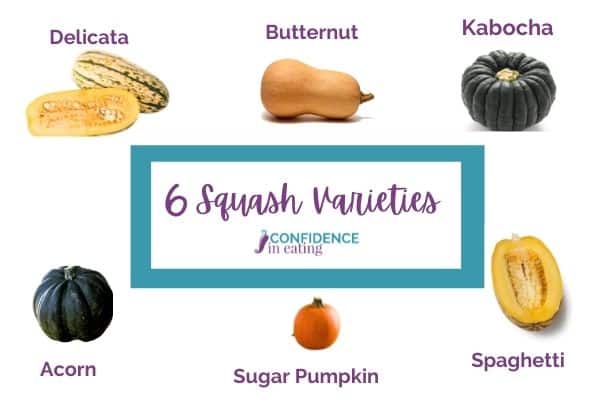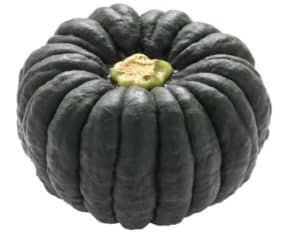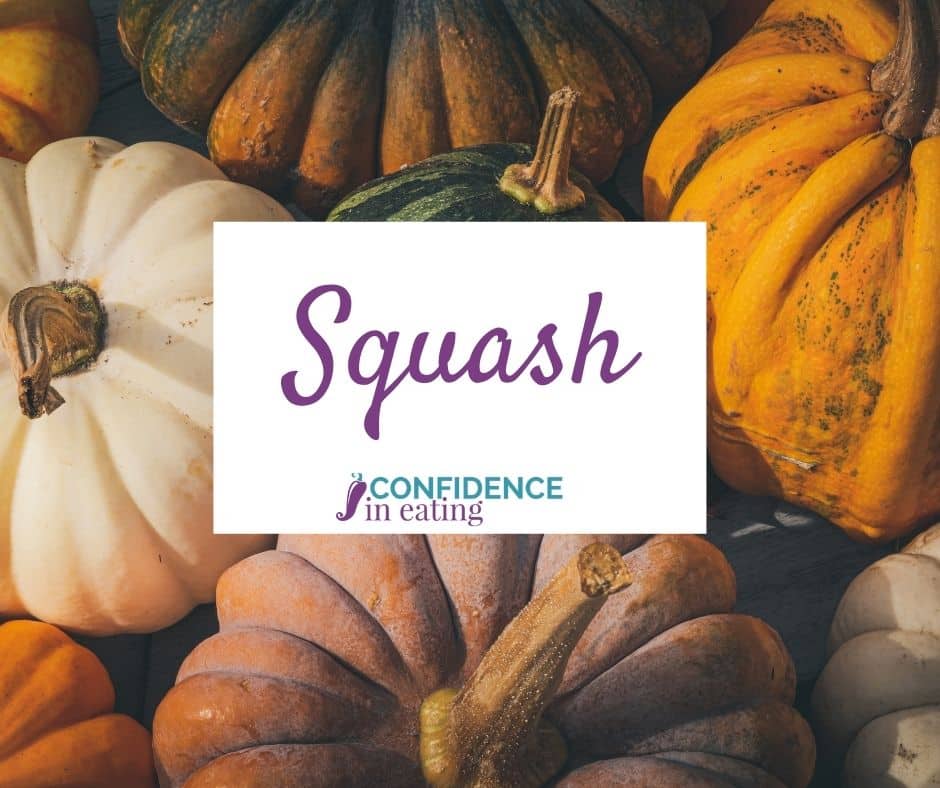Squash: from Stoup to Soup
I know how intimidating squash is to use. The mounds of colorful, tough-skinned squash and gourds you see outside the grocery store along with the more approachable, thin-skinned cousins nestle in their cozy produce-aisle beds. The nutrition benefits of squash add to the value of this tasty food.
Clients looking for ways to lower their carbohydrate intake find using squash in place of more traditional pasta can be a valuable exchange because of the lower carbohydrate and the nutrition benefits of squash. If you have had bariatric surgery such as gastric bypass or gastric sleeve and are having problems tolerating pasta, spaghetti squash can be a great way to bring spaghetti back into your meals because the noodles do not dough up like traditional noodles.
There’s no doubt that members of the Cucurbitaceae family, notably pumpkins, gourds, and winter squash, are beautiful, if not interesting, ornamental works of Mother Nature. But it seems that many are destined to be arranged for decoration in many homes versus used as food from November through December. Clients love learning new foods that can be easily added to quick evening meals.
Of course, many people salivate at the thought of the delicious pumpkin pies, latte’s, and pumpkin bread connected with the change of seasons and the aromas associated with autumn. Adding squash varieties to your meal routine is a great way to add flavor and nutrients.
Is squash the same thing as pumpkin?
Both pumpkins and squash come from the Cucurbitaceae family and have tasty flesh and seeds that can be used in recipes. Many people think of pumpkins as the traditional big orange varieties that are carved out at Halloween. Squash and pumpkins are so close to each other that the difference in categories really doesn’t matter.
Kind of like the difference between pumpkin pie and sweet potato pie, are they really that different from each other?
Underneath their colorful, sometimes rough, the exterior is nutrient-dense flesh that does really well in soups – it’s just the right amount of starch to yield a creamy texture. Of course, straight-up baking or roasting your squash is always an option. Many varieties have edible skins and do not need to be peeled.

Spaghetti squash
Spaghetti squash is a wonderful, lower-starch winter squash to use in place of pasta.
Nutrition benefits of squash
- vitamin A, important with vision, immunity, and the skin
- fiber, important to support your body’s detoxification process, assists with regularity and lowering cholesterol
- vitamin C, an antioxidant that helps neutralize free radicals in the body and can help decrease the length of a cold
My favorite way to enjoy the nutrition benefits of squash is with olive oil, spinach, almonds, and basil. Another easy way to use squash is with your traditional spaghetti sauce.
Acorn squash:
Acorn squash varies in color from dark green to tie-dyed green with orange shades. The flesh is less sweet than kabocha and is more yellow than orange. Just one cup provides more than 25% DV of vitamin C. You can soften the squash if needed by heating in the oven, although it is small enough that this may not be needed.
This squash has been one of the easy fall dishes I like to make. Just trim the top from each squash, invert squash on the cutting board, and slice from bottom to top to create two halves. Remove seeds and place to the side for roasting.
Choose your cooking method:
- bake the halves with a drizzle of olive oil and a touch of maple syrup for 30 minutes at 350°F
- cook in the microwave on high for 4 – 6 minutes with a little butter and cinnamon.

Kabocha
Also known as Japanese pumpkin, kabocha squash has green skin, orange flesh, and a shape similar to pumpkin. The flesh is super sweet when cooked. The nutrition benefits of this squash is the rich in beta-carotene – 1 cup has more than 200% DV of vitamin A!
Place the whole squash in the oven at 350°F for about 20 minutes to soften the skin – it will make cutting, peeling, and chopping an easier and much safer experience.
Try using kabocha in place of the butternut squash in your favorite soup.
Sugar Pumpkin:
Sugar pumpkins look a lot like carving pumpkins so be sure to select those marked especially for cooking. They are sweeter than those cultivated for jack-o-lantern displays.
The best way to cook the flesh is to roast the entire pumpkin – this allows the flesh to remain moist and helps the sugars to develop.
- Start by removing the stem from the pumpkin, rinse, and make several slits through the skin with a sharp knife.
- Bake at 350°F for about an hour.
- Remove from the oven and let sit until cooled.
- Cut the top portion off [around where the stem would be], remove seeds, and scoop out the flesh.
Try adding the pumpkin meat to hummus, overnight oats, or stir into your yogurt for the added nutrition benefits of squash.
Delicata squash:
Delicata squash has a mild, nutty flavor, firm flesh, and thin edible skin. Probably on the top of our list for ease of preparation. This recipe is delicious enough to eat on its own as a fiber-rich snack!
- rinse squash
- cut in half
- remove seeds (save to side for roasting later)
- slice into half-moon
- toss with some olive oil and salt
- bake at 350°F for about 20 minutes until browned
Save money and add nutritional value
Food companies use systems to be more profitable by using every portion of foods, minimizing waste and you can too!
Repurpose the compost-worthy waste into tasty snacks. Rinse flesh from seeds and lay the seeds on paper towels to dry. Flavor the seeds with your choice of options, depending on your mood:
Squash & Pumpkin Seed Flavors
Savory: toss with a bit of olive oil, seasoning of choice, and salt and pepper to taste.
Sweet: toss with melted coconut oil, a touch of maple syrup, cinnamon, and a pinch of salt.
Spicy: Add a little kick with some paprika and/or cayenne pepper
Sweet and savory combo: experiment with different combinations.
One of my favorite combos: cinnamon, paprika, salt, and pepper
Roast seeds on a parchment-lined baking sheet at 350°F for about 10-15 minutes or until lightly browned.
Seeds can be enjoyed as a snack or topping for salads, yogurt, oatmeal, or chia pudding.
Nutrient-packed simple squash uses
- Spaghetti squash with olive oil, spinach, almonds, and basil.
- Top spaghetti squash with your favorite marinara sauce.
- Try using kabocha in place of the butternut squash in your favorite soup.
- Bake the acorn squash halves with a drizzle of olive oil and a touch of maple syrup for 30 minutes at 350°F
- Slice acorn squash into half-moons to prepare for roasting.
- Acorn squash baked in the microwave with a little butter and cinnamon is fast and easy.
- Sugar pumpkin flesh can be added to hummus, overnight oats, or stirred into our yogurt.
- Delicata squash sliced into wedges and baked with olive oil and salt.
- Roasted seeds with 5 different flavor profile options
- Add squash flesh to your favorite soup
Clients work with me to find ways to increase the nutritional value and still enjoy all foods. We work together to enhance your confidence, resources, and skills for achieving your goals.
In the nutrition programs at Confidence in Eating, the courses are designed to build community, help support and encourage participants to accomplish their wellness goals.
Whether you are a client working with Confidence in Eating individually addressing emotional eating or part of a group program, finding practical solutions is key.
Lessons working on calming food cravings and learning how to release tension and anxiety around food and bodies are foundational. Culinary lessons, such as how to use squash, videos with time saving prepartion tips, and nutrient rich recipes are blended in a way that supports realistic wellness journeys.
Would you like more recipe ideas, exclusive discounts, and nutrition tips? Click here to be added to our newsletter list.
Remove food fear and overwhelm
Discover time saving kitchen strategies
Stop the uncontrollable carb cravings




